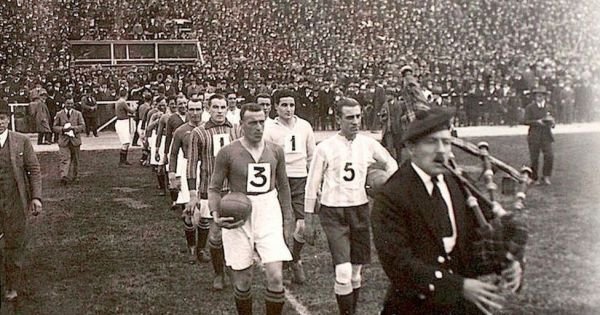The Scotchmen football club tour of Argentina and Uruguay in 1923
[ad_1]
The Scotchmen football club tour of Argentina and Uruguay in 1923
Third Lanark arrived in Argentina on 9 June 1923 after three weeks at sea
One hundred years ago, a Scottish football club embarked on a controversial overseas tour to Argentina and Uruguay. Are Third Lanark wise? was the question as the Glasgow club set sail for a summer in South America.
Third Lanark, one of Scotland’s top sides at the time, had toured the US and Canada in 1921, but not everyone was behind the latest expedition – a long trip to Argentina and Uruguay, where football was still developing.
The club initially had problems assembling a travelling party and padded out the squad with guest players from Motherwell, Hamilton, Raith, Falkirk, Clyde and Alloa.
Critics at home also said Third Lanark did not have the strength or financial resources for so-called missionary tours – arranged to encourage interest in the game and make some money – in far-off quarters of the globe.
But the visit was keenly anticipated in Argentina where nine years had passed since the last tour from a British club.
The main developers of the game in Argentina in the late 19th century were Scottish, says Argentine football historian and blogger Luis Marzoratti.
There was a huge expectation in 1923 and it wasn’t just Third Lanark – there were players from other teams – so they were seen as representative of Scottish football.
They were mainly called here not Third Lanark but the Scotchmen.
The tourists and a local select were piped onto the pitch in Buenos Aires for the first game – a sign behind proclaiming Welcome to the Scotchmen.
The hospitality ended there with Third Lanark – perhaps still re-adjusting to dry land after weeks at sea – beaten 1-0.
Thirds improved to win their second match but now the real tests were coming.
Scots crossed the border to face Uruguay in Montevideo in a game which ended 1-1.
Back home it was reported the quality of football was good, and the Scots’ performance an inspiration for Argentine football. But not everyone agreed.
There were complaints from Third Lanark of hostile crowds throwing missiles, while the Buenos Aires Herald suggested Thirds had none of the professional excellence expected from British teams.
Luis says: Expectations were so high that probably people were not satisfied with the first game.
To come to the River Plate in 1923 was not an easy journey. You have to travel three weeks by boat and the next day play the first game.
Some say the ball was smaller and the fields hard. The newspapers said at first that Third Lanark was not that good but as the tour developed, people realized that it was a very good team.
Peace had broken out but there was still time for one local paper to accuse goalkeeper Tom Ferguson of tricks.
It claimed he would cover his hands with pegapega, a sticky substance used in the Argentine for trapping birds, to better catch the ball.
The newspaper also said: He will also solicit permission to wear the traditional skirt of his country which will make it absolutely impossible for the ball to pass between his shapely legs.
There was no sign of adhesives or kilts as Third Lanark took to the field against Argentina.
Argentine president Marcelo Torcuato de Alvear looked on as a late goal from Thirds saved a 1-1 draw.
The tour would finish with Third Lanark defeating a combined Argentina/Uruguay team 2-1. They travelled home with a respectable record of four wins, two draws and two defeats.
Top scorer on the tour was guest player Hughie Ferguson of Motherwell, the man whose long standing record of goals in consecutive games for the Steelmen was recently beaten by Kevin van Veen.
The drama was not quite over with the Scots delayed by a typhoon, which was still light relief compared to the fate of the Raith Rovers team they met in the Canary Islands on the trip back.
The Kirkcaldy men had been shipwrecked off the coast of Spain on their own summer tour before eventually being ferried onwards by a passing liner.
The fortunes of Third Lanark would ebb and flow from there. In testing times after World War Two a parcel arrived at their Cathkin Park – a new set of jerseys courtesy of the Argentine FA.
But nothing could save Third Lanark in 1967 when the club collapsed as a result of mismanagement. All that remains of Thirds is the ruins of their old home on Glasgow’s south side, the dreams of a dwindling band of elderly supporters, and an amateur side at a lower level.
But far from the overgrown terraces of Cathkin Park, the name of Third Lanark lives on in South America.
It was a very positive tour for local football says Luis.
This was a turning point in South American soccer. In 1924 Uruguay won the Olympics and were more or less considered world champion. They won again in 1928.
For Argentina and Uruguay, this was just the starting point to reaching a place of high excellence in world soccer. (BBC)
[ad_2]
Source link




